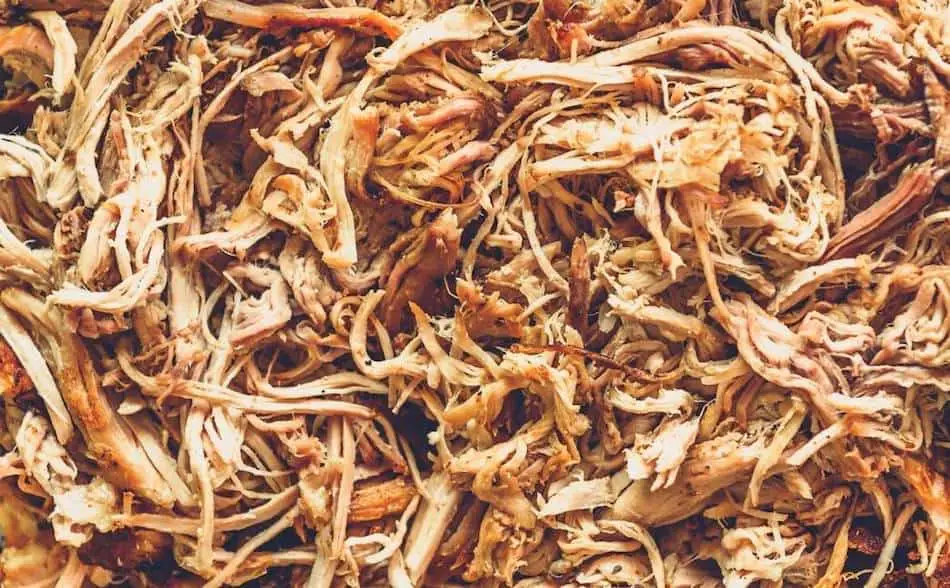
Dry smoked pork is a common problem that can be caused by a variety of factors. Properly cooking pork low and slow is essential to prevent the moisture from being drawn out of the meat. In this article, I’ll walk you through all the reasons smoked pork becomes dry. By following these steps, you can ensure that your smoked pork turns out moist and tender every time.
Dry smoked pork is a common problem that can be caused by a variety of factors. Properly cooking pork low and slow is essential to prevent the moisture from being drawn out of the meat. Adding moisture through basting, using a water pan, and brining the pork can also help to keep it moist. Resting the meat after cooking allows the juices to redistribute, helping to keep the pork moist. Finally, avoiding slicing the pork too soon after cooking can prevent the juices from being lost.
Key Points
- Wrapping pork butt in foil after 3-4 hours of smoking helps to retain moisture and prevent the meat from drying out.
- Basting the pork every hour with a liquid mixture helps to add moisture and create steam in the cooking chamber.
- Using a water pan in the smoker can create steam and deflect heat away from the meat.
- Cooking pork at low temperatures for a long period of time allows the fat and connective tissue to melt and add moisture to the meat.
- Brining the pork shoulder in a saltwater solution before smoking can help retain moisture.
- Resting the meat after cooking allows the juices to redistribute, helping to keep the pork moist.
- Avoid slicing the pork too soon after cooking as this can cause the juices to be lost.
1. Wrapping Pork Butt Keeps It Moist
Meat will absorb most of the smoke in the first few hours. After that, it doesn’t take on much more. Pork shoulders take 5+ hours to cook, which puts it at risk of drying out. As with most of the big meats, it’s better to wrap it up in foil after about 3-hours. At this stage, the roast should have developed a crust and would have absorbed a decent amount of smoke. After this point, it’s all about finishing it without drying it out. By wrapping the roast in foil, it will create steam and keep the meat nice and moist. Stick a probe through the foil to keep track of the internal temperature and leave the lid closed. You shouldn’t have to touch it after this point. Foil will also help the roast push through the stall. If you don’t know what the stall is, it’s when the meat hits a brick wall and refuses to finish. The internal temperature plateaus, and can sometimes stay there for a while. Eventually it pushes through if you can hold the temperature of your cooker.
To wrap a pork roast:
- Wait until the roast has been smoking for 3-4 hours.
- Remove the roast from the smoker and wrap it in foil.
- Place a probe through the foil to keep track of the internal temperature.
- Return the wrapped roast to the smoker and continue cooking until it reaches the desired internal temperature.
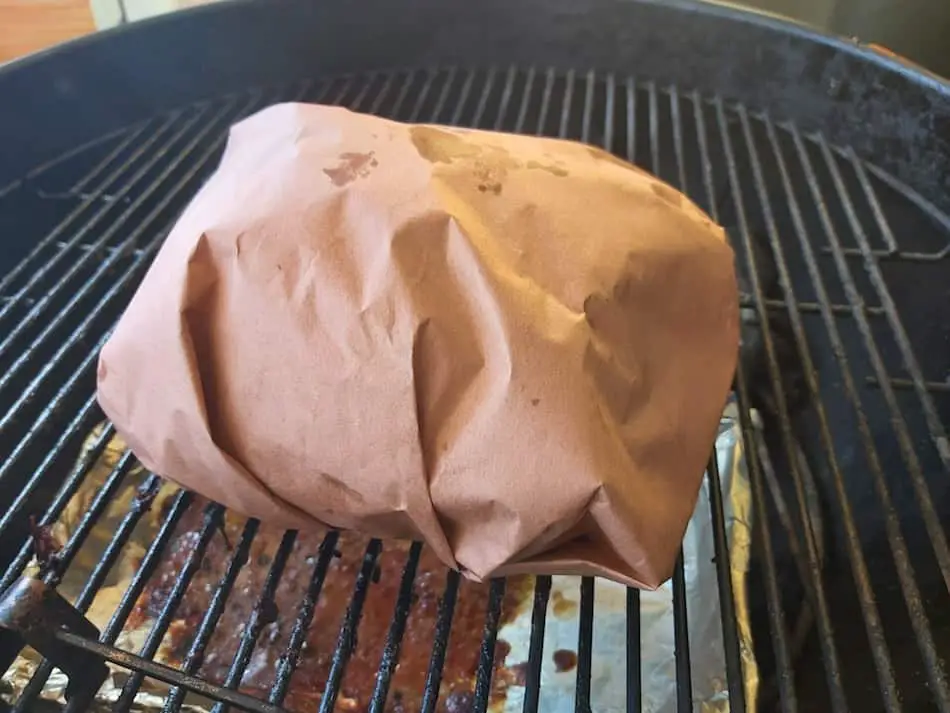
Aaron Franklin Pork Butt (Pulled Pork) Recipe And Technique
2. Add Moisture By Basting
Spritzing and basting smoked pork with a liquid mixture can help to keep it moist by adding moisture to the surface of the meat and creating steam in the cooking chamber. This can help to prevent the meat from drying out and becoming tough.
Pork will benefit form hourly basting in the first 3-hours prior to wrapping in aluminium foil. A basting sauce is usually a combination of apple cider vinegar and water, or apple juice. I find a spray bottle works best because it’s good to move fast.
You never want to leave the lid open for long, otherwise you will mess with the temperature. You can use a mop brush and a mop sauce, it doesn’t really matter. What’s important is that you are adding moisture to the meat and creating steam in the cooking chamber.
To spritz pork in a smoker:
- Use a spray bottle to spritz the pork every hour during the first 3-4 hours of smoking.
- Spritz the pork with a mixture of apple cider vinegar and water, or apple juice.
- Avoid leaving the lid of the smoker open for too long to maintain a consistent temperature.
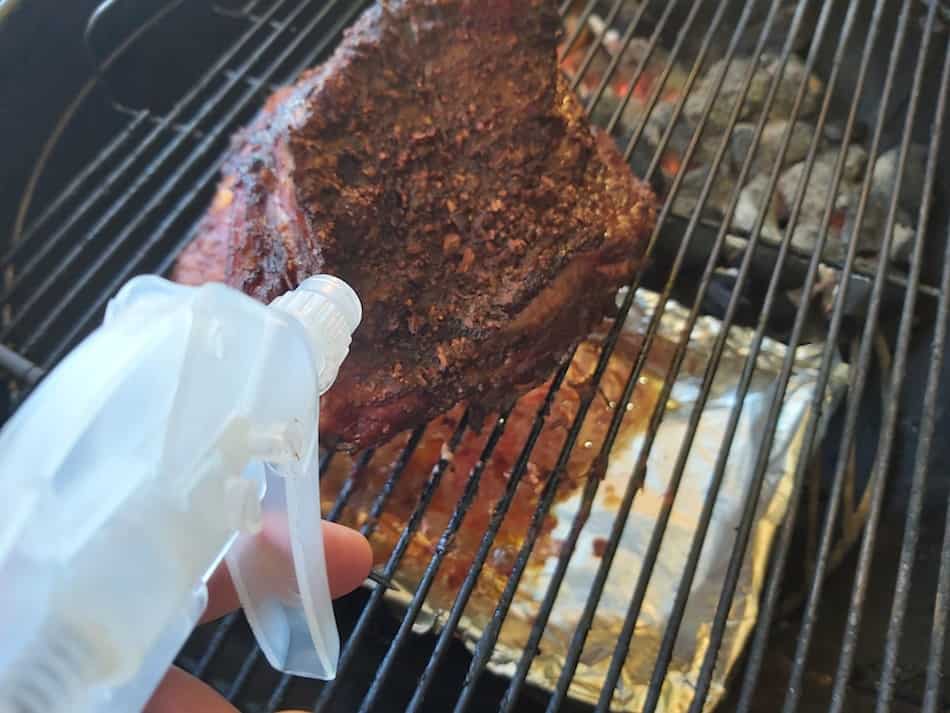
3. Use A Water Pan
Another way to add more moisture to the cooking chamber is by using a water pan. Water will create steam, but it will also work as a shield to deflect heat from the meat. Low-and-slow cooking is all about avoiding high heat and cooking the meat in the cool-zone. Water pans are unnecessary with some smokers, but they are beneficial for most charcoal smokers. If your smoker is struggling to come up to the 225°F to 250°F temperature range, then maybe skip the water pan.
A water pan in a smoker can help to retain moisture in the cooking chamber by creating steam. The steam helps to keep the meat moist and can also help to regulate the temperature of the smoker, ensuring that the meat is cooked at a consistent low temperature.
To use a water pan in a smoker:
- Fill the water pan with water before starting the smoker.
- Place the water pan in the smoker, ensuring that it is not directly under the meat.
- Check and refill the water pan as needed to ensure that it does not run dry.
- Low and slow cooking temperatures:
- 225-250°F is a common temperature range for low and slow cooking.
- Some recipes may call for cooking at a lower or higher temperature, depending on the specific type of meat and desired final product.
4. Keep The Temperature Low
When meat cooks at low temperatures for a long period, magic happens. All the fat and connective tissue melts and renders into the meat and creates gelatine. When a roast is cooked for too long at a high temperature, all the moisture escapes leaving the meat dry. High heat works well on thinner meats, but not form slow cooking. Pork shoulders contain a lot of fat and connective tissue, so it needs to reach an internal temperature of 200-203°F to be considered done.
Low and slow cooking is a technique that involves cooking meat at a low temperature (around 225-250°F) for an extended period of time. This allows the fat and connective tissue in the meat to melt and render, creating a moist and tender final product. Cooking meat at high temperatures can cause the moisture to be drawn out of the meat, resulting in a dry and tough final product.
Smoked Pulled Pork At What Temp? We Found The Best Times And Temperatures
How To Cook Low-and Slow
The best way to cook low-and-slow is by using an indirect cooking method, or two-zone cooking. Direct cooking is when the meat is directly above the fire whereas indirect cooking is where the meat sits on the opposite side of the fire. This setup isn’t necessary for electric, gas and pellet smokers, but is what can be used with charcoal smokers. Some smokers like Bug Green Eggs and other kamado smokers have a deflector plate that can shield the meat from the flames, which is another form of indirect cooking.
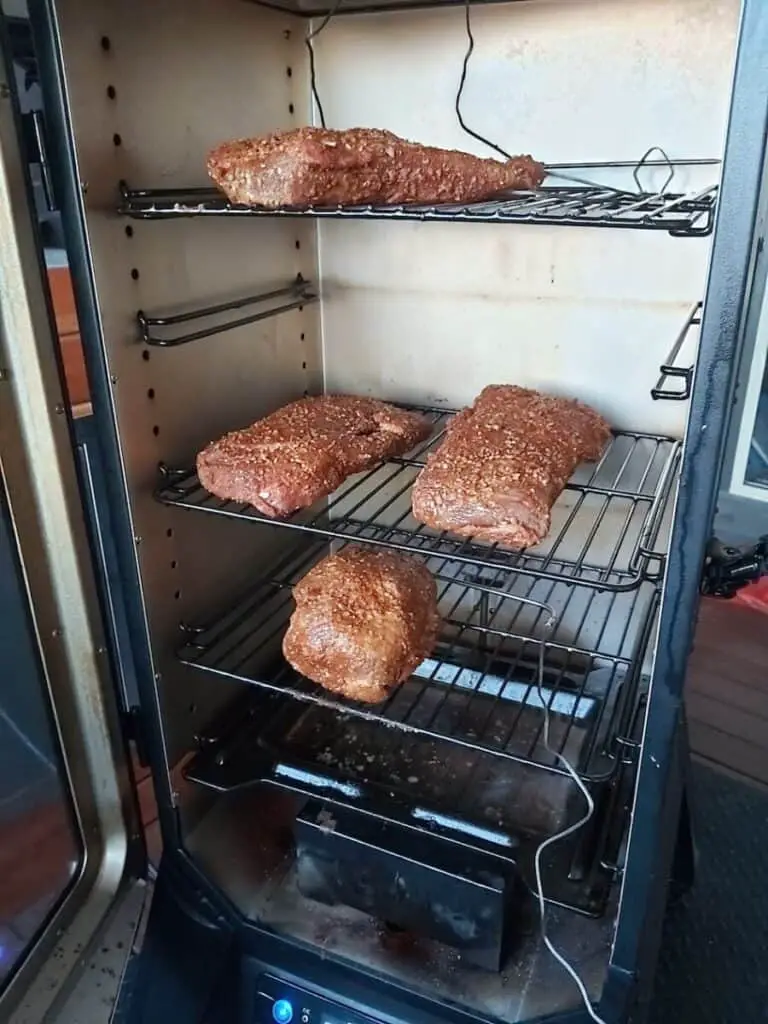
5. Brine Your Pork Shoulder
Adding salt to the meat is another way your pork roast can retain moisture. Dry brining by rubbing salt into the meat the day before will penetrate the meat and help keep moisture during the cooking process. The other benefit of applying salt to the meat is it will enhance the flavor. Wet brining is another common method, popular with chicken. However, dry brining is less fuss, less mess and gets the job done.
Brining pork with salt can help to retain moisture in the meat by drawing the juices from the interior of the meat to the surface. The saltwater solution also helps to break down the proteins in the meat, making it more tender.
To dry brine pork:
- Sprinkle salt over the surface of the pork and rub it into the meat.
- Place the pork in the refrigerator for 4-24 hours before smoking.
- The amount of salt used and the length of time the pork is brined will depend on the size and type of the meat.
Injecting Pork Butt: Tips, Tricks, and Techniques
6. Allow Your Pork To Rest
If you slice or shed your pork roast too soon after cooking, all the moisture in the meat will seep out onto the cutting board and your pork won’t be as juicy. Let the meat rest for about 20-minutes to allow the roast to reabsorb some meat juices.
Resting pork after cooking allows the juices that have been released during the cooking process to redistribute throughout the meat. This helps to keep the pork moist and prevents it from drying out. Resting the meat for a sufficient amount of time is particularly important when cooking large cuts of pork, as the juices need time to redistribute throughout the meat.
To rest pork:
- After the pork has finished cooking, remove it from the smoker and place it on a cutting board.
- Tent the pork with foil and allow it to rest for 10-15 minutes.
- This allows the juices to redistribute throughout the meat, helping to keep it moist.
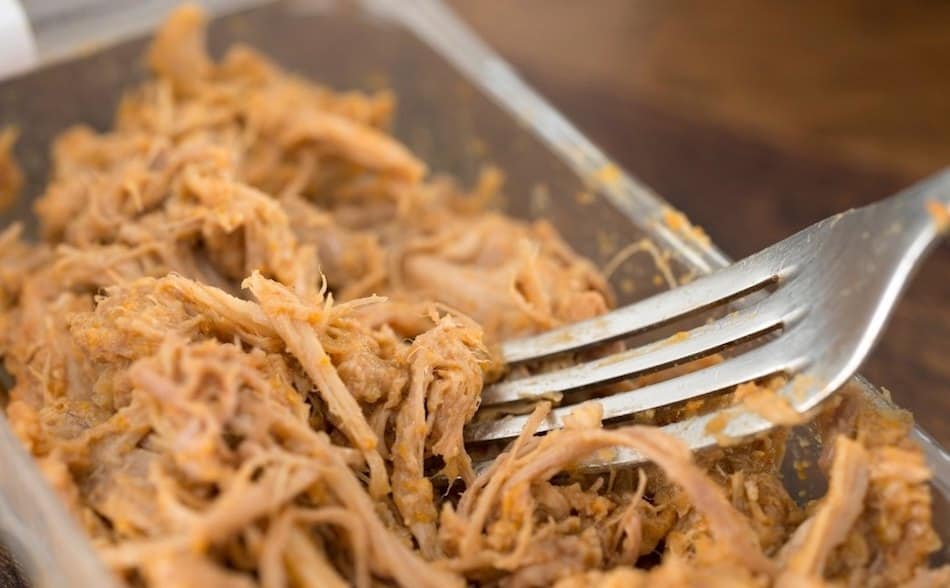
7. Use Fresh Shoulder, Not Frozen
Fresh meat is always the preferred option. If meat has been frozen, it will retain less moisture than fresh meat because of the structural changes that have taken place at a cellular level.
Fresh pork is generally considered to be of higher quality and more flavorful than frozen pork because it has not been subjected to the freezing process. When meat is frozen, the water inside the cells expands, causing the cells to rupture.
When the meat is thawed, the juices that were previously trapped inside the cells are released, resulting in a drier and less flavorful product. In contrast, fresh pork has not undergone this process and therefore retains more of its natural juices, resulting in a moister and more flavorful final product.
To buy good pork for smoking:
- Look for pork that is pale pink in color and well-marbled with fat.
- Avoid pork that has a strong odor or is discolored.
- Choose pork that is fresh or properly frozen if not using it immediately.
8. Use Thermometers To Control Temperature
Controlling the temperature of your smoker is one of the most important factors when smoking meat low-and-slow. If you don’t know what’s going on inside your meat and inside the cook chamber, then your meat is at risk of turning out dry.
Therefore, one of the most important tools on your meat smoking journey will be a wireless thermometer. If you don’t have one of these, you will cook blind. A leave-in thermometer will help you track the temperature of the cook chamber and the internal meat temperature at the same time. A wireless, duel-probe thermometer will allow you to track the meat with one probe and the cooker by clipping the other probe to the grill grate. You can set the target temperatures on the wireless thermometer handset and it will alarm when the target temperature has been reached. Being able to monitor the cooking chamber is critical. Often, the temperatures inside smokers will fluctuate, and if left unattended, can get too hot and ruin your meat. If you use a wireless thermometer, you can make adjustments to the vents whenever the temperature rises or falls.
You don’t have to spend an arm and a leg on meat thermometers, you can get a decent one for about $50. I still use my trusty old ThermoPro TP20, it’s not fancy, but it’s tough, reliable and accurate, which is why it’s the number one selling meat thermometer on Amazon. Last time I checked, the TP20 was about $50, but you can check the lasted price here.

Will Cooking the Pork in a Pan Help Retain Moisture?
Smoking pork roast in a pan can be a good way to add flavor and moisture to the meat, but it has some potential drawbacks as well. One pro is that the pan will catch any juices that drip off the pork, which can help to keep the meat moist. However, the pan may also prevent the pork from getting a crispy, caramelized bark, since the juices will keep the surface of the meat from coming into direct contact with the heat of the smoker. Additionally, the pan can make it more difficult to maintain a consistent temperature while smoking, as the juices in the pan may cause the temperature to fluctuate.
Pros: Can help to keep the meat moist
Cons: May prevent the formation of a crispy bark. Also, can make it harder to maintain a consistent temperature
Fat-Side-Up or Fat-Side-Down?
The position of the fat on the pork roast can affect the moisture content of the meat. In general, cooking the pork with the fat side up will allow the fat to melt and baste the meat as it cooks, helping to keep it moist. On the other hand, cooking the pork with the fat side down may cause the fat to drain away from the meat, resulting in a leaner, drier roast.
Pulled Pork Sliders – (How To Smoke a Pork Butt For Sliders)
Do Meat Grades Make a Difference?
To buy good graded pork, you should look for pork that is graded as “Acceptable” by the USDA. This grade of pork should have a high proportion of lean meat to fat and bone, and it is the only grade of fresh pork that is sold in supermarkets. You can also ask the staff at the meat counter or the manager of the store for more information about the grading of the pork that they have available. They should be able to tell you whether the pork has been graded and, if so, what grade it received. Additionally, you can check the label on the packaging of the pork to see if it has been graded by the USDA or other government body.
All of the Different Pork Roasts
| Cut | Description | Cooking Method |
|---|---|---|
| Pork shoulder | Large, tough cut well-marbled with fat | Slow-cook or smoke |
| Pork leg | Large, meaty cut; also known as ham | Low, slow heat |
| Pork loin | Leaner cut of meat | Roast or grill |
| Pork ribs | Flavorful cut of meat | Grill, smoke, or oven |
| Pork belly | Fatty cut of meat | Grill, smoke, or oven |
Pork shoulder, also known as pork butt or Boston butt, is a large, tough cut of meat that is well-marbled with fat. It is often slow-cooked or smoked to make pulled pork or other dishes. Pork leg, also known as ham, is a large, meaty cut that is typically cured and cooked using low, slow heat. Pork loin is a leaner cut of meat that is often roasted or grilled. Pork ribs are a flavorful cut of meat that can be grilled, smoked, or cooked in the oven. Pork belly is a fatty cut of meat that is often used to make bacon or used in dishes such as pork belly sliders.
In terms of moisture retention, pork shoulder and pork belly are generally less likely to dry out due to their high fat content. Pork loin and pork leg are leaner cuts that are more prone to drying out if not cooked properly. It is important to use a low and slow cooking method and to baste or wrap the meat in foil to help retain moisture.
The Best Smoking Wood to Flavor Pork
| Wood Type | Description | Description |
|---|---|---|
| Apple | “A mild fruit wood that adds a sweet, subtle flavor to pork. Great for creating a delicate taste and aroma.” | “Apple is my go-to wood for smoking pork. It adds a nice, subtle sweetness that pairs perfectly with the rich flavor of pork.” |
| Cherry | “A fruity wood with a sweet and mild flavor. Good for adding a touch of color to the finished product.” | “Cherry wood is a great choice for smoking pork. Its mild, sweet flavor pairs well with the rich flavor of pork, and it also adds a nice touch of color to the finished product.” |
| Maple | “A mild wood with a sweet, subtle flavor. Good for adding a hint of sweetness to pork.” | “Maple is a great wood for smoking pork. Its mild, sweet flavor adds a nice depth of flavor to the finished product.” |
| Oak | “A strong, robust wood with a bold flavor. Good for adding depth and character to pork.” | “Oak is a classic wood for smoking pork. Its strong, bold flavor adds depth and character to the finished product.” |
| Pecan | “A mild nutty wood with a sweet and nutty flavor. Good for adding a subtle depth of flavor to pork.” | “Pecan is a great wood for smoking pork. Its mild, nutty flavor adds a subtle depth of flavor to the finished product.” |
How to Get a Crispy Bark Without Drying Out the Pork
Developing a crispy bark on pork when smoking is all about getting the right combination of smoke, heat, and time. According to barbecue experts and competition pitmasters, here are some tips for achieving the perfect pork bark:
- Start with a dry rub: “A dry rub is essential for creating a crispy bark on pork. Look for a rub that contains sugar, salt, and paprika for the best results.”
- Use the right wood: “The wood you use for smoking can have a big impact on the flavor and texture of the bark. Hardwoods like oak and hickory are great choices for a crispy bark.”
- Keep the temperature steady: “Maintaining a consistent temperature is key to getting a crispy bark. Aim for 225-250 degrees Fahrenheit and use a good quality thermometer to monitor the temperature.”
- Don’t wrap the pork: “Wrapping the pork in foil or butcher paper can trap moisture and prevent the bark from forming. Let the pork smoke uncovered to get the best results.”
- Be patient: “Developing a crispy bark takes time. Plan on smoking the pork for at least 6-8 hours to allow the bark to form properly.”
- Finish it off with a glaze: “A glaze made with equal parts brown sugar and apple cider vinegar can add a delicious, sticky finish to the bark. Brush it on in the last 20-30 minutes of cooking.”
The Best Temperatures For Pork
To avoid overcooking pork, it’s important to use a reliable meat thermometer and cook the pork to the appropriate internal temperature. Here is a table with the recommended internal temperatures for different cuts of pork:
| Cut of Pork | Recommended Internal Temperature |
|---|---|
| Pork Butt/Shoulder | 195°F – 200°F |
| Pork Belly | 155°F – 160°F |
| Pork Ribs | 190°F – 200°F |
| Pork Tenderloin | 145°F |
| Pork Chops | 145°F |
My Favorite Meat Smoking Tools
Thanks for checking out this article. I hope you learned a few things. Here are some of my favorite tools I use when smoking brisket that may be useful to you. These are affiliate links, so if you decide to purchase any of these products, I’ll earn a commission. But in all honesty, these are the tools I recommend to my family and friends who are just starting out.
Meat Thermometer: There are dozens of fancy thermometers on the market, but I still use my trusty TP20. For around $50, I have a high-quality meat thermometer with two probes, and can track the temperature of my smoker with one probe, and my meat with the other probe. The ThermoPro TP20 is an Amazon Best Seller because it’s the easiest thermometer to operate, is durable, highly accurate, and comes with pre-programmed meat settings.
Instant Read Thermometer: Arguably, the second most important tool you need is a fast and accurate instant-read thermometer. These tools play an important role in the latter stages of the cook when the meat needs regular checking in multiple areas. I use the ThermoPro TP19 because it can do everything a ThermaPen can do, but for a fraction of the cost. You can check out the TP19 on Amazon here.
Wireless Thermometer: The latest thermometers on the market have no wires and can be controlled by wi-fi via your phone. Airprobe 3 is the best of this technology.
Butcher Paper: Wrapping brisket in butcher paper has become a huge trend in barbeque thanks to Aaron Franklin. Wrapping your brisket in paper will give you a nice brisket bark. However, you can’t just use any old paper, it has to be unwaxed, food grade paper. You can find it on Amazon here.
Advanced Thermometer and Automatic Temperature Controller: Once you’re ready to take things seriously, the FireBoard 2 Drive is a six-channel Bluetooth/Wi-Fi thermometer that can monitor up to 6 pieces of meat, control and graph your cook sessions on your smartphone, and attaches to an an automatic blower that will convert your charcoal smoker to a set-and-forget. This is one of the most advanced meat thermometers on the market. You can check it out on the FireBoard website here.
Related:
Wrap Pork Butt At What Temp? (When To Wrap Pork Shoulder)
How To Smoke Pulled Pork on a Smoker (Smoked Pork Butt)
Bitter Smoked Meat? Here’s Why
